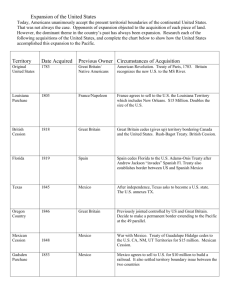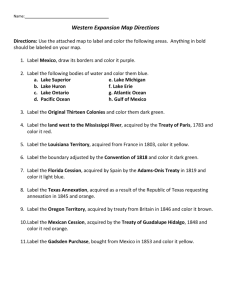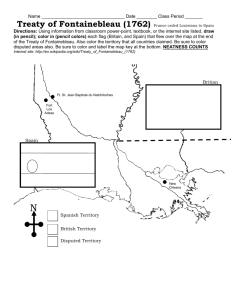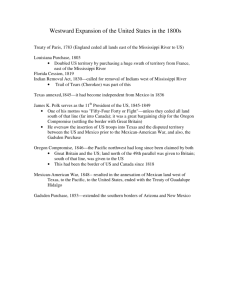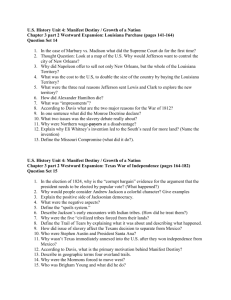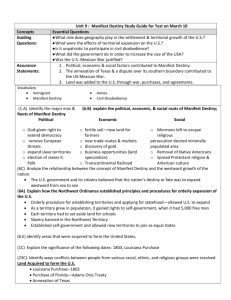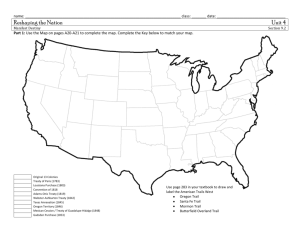File
advertisement
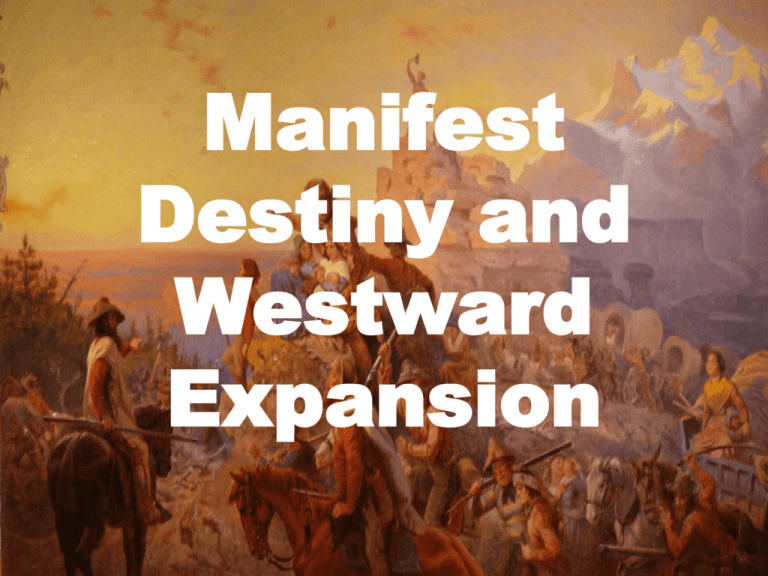
Manifest Destiny and Westward Expansion Manifest Destiny: the belief that it was the destiny of the U.S. to expand its territory over the whole of North America and to extend and enhance its political, social, and economic influences. Political: A. Expand Democracy – Americans believed it was their mission to expand democracy and be an example for the rest of the world B. Security – occupying the entire middle part of the continent, from coast to coast, would discourage threats from other countries such as England, Spain and Russia Manifest Destiny: the belief that it was the destiny of the U.S. to expand its territory over the whole of North America and to extend and enhance its political, social, and economic influences. Economic: Americans believed that future prosperity depended on the land and wealth gained from westward expansion. The success of farmers in Texas and the discovery of gold in California encouraged this belief Manifest Destiny: the belief that it was the destiny of the U.S. to expand its territory over the whole of North America and to extend and enhance its political, social, and economic influences. Social: A. The pioneer spirit – seen as the perfect example of American Individualism. Americans admired the rugged pioneers who braved the wilderness and relied on themselves. B. The Romanticizing of the West – Americans idealized the west in paintings (Hudson River School), music, literature, and later, movies We are destined to control North America from the Atlantic to the Pacific! Who is Manifest Destiny bad for? ✓ ✓ ✓ ✓ ✓ ✓ ✓ Things to do... Buy Louisiana from France Convince Spain to give us Florida Organize our border with Canada Get Texas to join Get Oregon all to ourselves Steal half of Mexi... Oops, I mean defend ourselves against Mexico (and hopefully get California, Arizona, Nevada, Utah...) Buy Gadsden Purchase for a railroad Manifest Destiny Sucks! Louisiana Purchase, 1803 Details: ❑ U.S. had a treaty with Spain to use New Orleans. When Spain gave Louisiana back to France, the U.S. had no treaty ❑ Jefferson offers to buy just New Orleans; Napoleon offers the whole territory for $5 million more. Total cost = $15 million ❑ U.S. Doubles in size Effect on National Security: ❑ U.S. Now controls New Orleans ❑ U.S. controls entire Mississippi River and its tributaries ❑ U.S. now has a large “buffer zone” between her populated areas (mostly east coast) and New Spain ❑ U.S. gains Florida! ❑ Spain and U.S. formalize the borders between New Spain and Louisiana Purchase Territory Adams-Onis Treaty Details: ❏ Seminole Indians were raiding U.S. from Spanish Florida ❏ Jackson takes Spanish forts in his crackdown on the Seminoles ❏ Monroe offers to buy Florida, since Spain is unwilling or unable to maintain control there ❏ Spain wants to get rid of Florida because its power is weakening in the Americas and it needs to put more resources into controlling her other colonies James K. Polk: ● 11th President of the United States. Number 1 campaign promise: gain total U.S. control over Oregon. ● A Jacksonian Democrat, his nickname was: “Little Hickory” ● One campaign slogan was: “54° 40’ or Fight!” ● Said he would serve one term only, then retire. (Which he did!) President Polk If we don’t get Oregon all the way North to 54⁰ 40’ parallel, we will FIGHT! (or we’ll settle for the 49th, I guess) Slave population Who is Manifest Destiny bad Manifest for? Destiny Sucks! War with Mexico! Causes: ❏ Manifest Destiny - U.S. felt it was their destiny to control N. America and Mexico was in the way ❏ Annexation of Texas – Mexico still claimed Texas, Texas and the U.S. regarded Texas as independent ❏ Border dispute – U.S. says Rio Grande; Mexico says Nueces ❏ Soldiers clash in the disputed area Effects: ❏ U.S. invades Mexico ❏ After Mexico City falls Mexico cedes their northern territory to the U.S. ❏ U.S. now possesses what is now California, Nevada, Utah, Arizona, New Mexico and parts of other states ❏ The border between the two countries is set at the Rio Grande There were conflicts with Britain, as well!! (But not war) Mexican Cession Trans-continental Railroad ❏ More people and more goods are able to travel faster (6 months in a covered wagon from Missouri to west coast vs. 1-2 weeks by train) ❏ Towns spring up along rail lines ❏ Western farms expand because trains provide a market back east for their crops and livestock GOLD!!!! ❏ Discovered near San Francisco, California in 1848 ❏ In 1849 thousands rush to California hoping to strike it rich. They are known as “49ers” ❏ California’s population triples in about 10 years ❏ While most do not find gold, California’s temperate climate and fertile soil allow many to become successful as farmers and ranchers ❏ Cities develop as a result of the large migration Territory Original United States Date Acquired Previous Owner 1783 Great Britain How was territory Acquired? Revolution/ Treaty of Paris Territory Date Acquired Previous Owner How was territory Acquired? Original United States 1783 Great Britain Revolution/Treaty of Paris Louisiana Territory 1803 France Purchase Territory Date Acquired Previous Owner How was territory Acquired? Original United States 1783 Great Britain Revolution/Treaty of Paris Louisiana Territory 1803 France Purchase British Cession 1818 Great Britain Treaty Territory Date Acquired Previous Owner How was territory Acquired? British Cession 1818 Great Britain Treaty Spain AdamsOnis Treaty Florida Cession 1819 Territory Date Acquired Previous Owner How was territory Acquired? British Cession 1818 Great Britain Treaty Florida Cession 1819 Spain Adams-Onis Treaty Texas 1845 Texas Annexed Territory Date Acquired Previous Owner How was territory Acquired? Florida Cession 1819 Spain Adams-Onis Treaty Texas 1845 Texas Annexed 1846 Great Britain Treaty Oregon Country Territory Date Acquired Previous Owner How was territory Acquired? Florida Cession 1819 Spain Adams-Onis Treaty Texas 1845 Texas Annexed Oregon Country 1846 Great Britain Treaty Mexican Cession 1848 Mexico Treaty of Guadalupe Hidalgo after war of conquest Territory Date Acquired Previous Owner How was territory Acquired? Oregon Country 1846 Great Britain Treaty Mexican Cession 1848 Mexico Treaty of Guadalupe Hidalgo Gadsden Purchase 1853 Mexico Purchased Territory Date Acquired Previous Owner How was territory Acquired? Alaska 1867 Russia Purchase ($7.2 million) Territory Date Acquired Previous Owner How was territory Acquired? Hawaii 1898 Hawaii Annexation Acquisitions in chronological order: British Cession 1818 Oregon Territory 1846 Mexican Cession 1848 Gadsden Purchase 1853 Louisiana Purchase 1803 Texas Annexation 1845 Treaty of Paris 1783 13 original colonies Florida Cession 1819 Urbanization in the North: Poor soil + long, cold winters = little agriculture Long, cold winters + fast moving streams + a willing workforce = power and labor for factories Factories = need for large labor force near by Large numbers of people living near each other = cities Foreign Policy: (noun) a policy pursued by a nation in its dealings with other nations, designed to achieve national objectives. National Objective of the U.S. in 1840s: Manifest Destiny Result? ❑ Treaty with Britain over Oregon Territory ▪ After a threat of war (remember, “54⁰ 40’ or FIGHT!”) ▪ Border set at the 49th parallel ❑ War with Mexico ▪ After trying to buy California and New Mexico, Polk picks a fight ▪ Treaty of Guadalupe Hidalgo ends the war ▪ U.S. gains huge tract of land from Mexico Physical Geography and Manifest Destiny: Natural borders: Rivers, mountains, oceans, deserts Control Mississippi = control of inland waterways Ocean borders protect against foreign invasion Isolation from Europe by Atlantic keeps U.S. out of European wars (until WWI, anyway) Acquisitions in chronological order: British Cession 1818 Oregon Territory 1846 Mexican Cession 1848 Gadsden Purchase 1853 Louisiana Purchase 1803 Texas Annexation 1845 Treaty of Paris 1783 13 original colonies Florida Cession 1819 Acquisitions: How obtained Treaty negotiations Treaty negotiations War of conquest Purchased for $15 million Revolution 13 original colonies Annexation Purchased $10 million Adams-Onis Treaty+ $5 million Rocky Mountains Border between U.S. and Louisiana Territory = Mississippi River Great Plains Mormons found Salt Lake City, Utah Gold Discovered near San Francisco, CA Proclamation Line of 1763 drawn along the Appalachian Mountains TEKS 8.21A: identify different points of view of political parties and interest groups on important historical and contemporary issues Nativism: a policy or belief that protects or favors the interest of the native population of a country over the interests of immigrants. Know-Nothings (The American Party): a political party that arose in the mid 1800s in reaction to the large number of mostly Irish, Catholic immigrants. They proposed denying suffrage and citizenship to Catholics. Anti-Catholic (feared that if Catholics were elected they would be controlled by the Pope – too much like a king) Anti-Irish (Most Irish immigrants were Catholic) Anti-immigrant (Though they made it sound like they only wanted to protect democracy, it seems more that they feared the changes immigrants brought with them to the society.) Also Anti-alcohol (Not all temperance reformers were Know Nothings.) Definition: Melting pot is a concept referring to a society becoming more unified with the different elements “melting together” into a harmonious whole with a common culture. It is most commonly used to describe the assimilation [blending in] of immigrants to the United States. TEKS 8.23A: identify selected racial, ethnic, and religious groups that settled in the United States and explain their reasons for immigration Country of Origin Push Factors Pull Factors Britain Push: not enough land, jobs, religious freedom Pull: Land, jobs, freedom, adventure Ireland Push: Famine, oppression Pull: Jobs, food, religious freedom political turmoil in China Pull: Jobs, food, religious freedom European Jews Religious persecution in Russia, Poland, Germany, Romania and other countries Jobs, religious freedom Germany Push:, High rent/land prices Pull: Good, inexpensive political unrest, some religious farmland persecution Chinese Economic opportunity, the Gold Rush Country of Origin Contributions to economic and demographic growth: Where did they settle? What did they do? Britain Established colonies, then the U.S., contributed to politics, religion, education, agriculture Established English colonies along East coast, settled throughout North America Ireland Catholic numbers grow, Nativism increases, by second and third generation the Irish are involved in government, police, and fire departments Settled in eastern cities where they arrived; Boston, New York, and Philadelphia, worked in factories, railroads, military, as maids, nannies Chinese Miners, construction, railroads California, west coast, inland with the railroad European Jews Factory workers, education, banking, law, arts Various towns in mostly eastern U.S., Charleston, New York, Baltimore Germany Various Protestant denominations, cultural aspects, farmers, factory workers, often brought coimmigrants from home towns and villages West: Wisconsin, Michigan, Missouri, Texas
